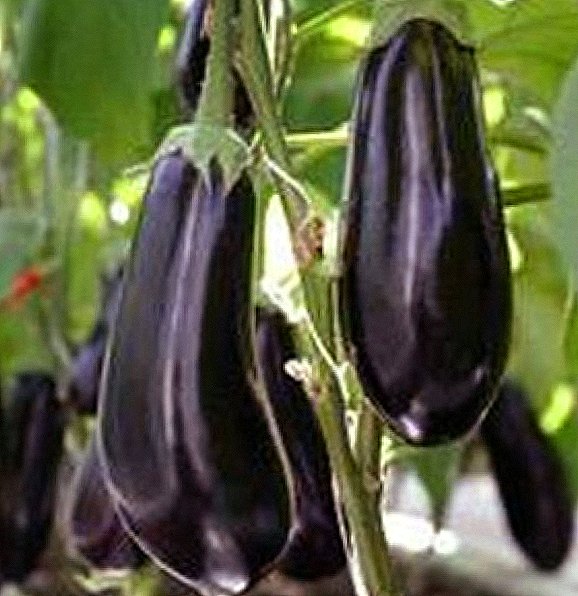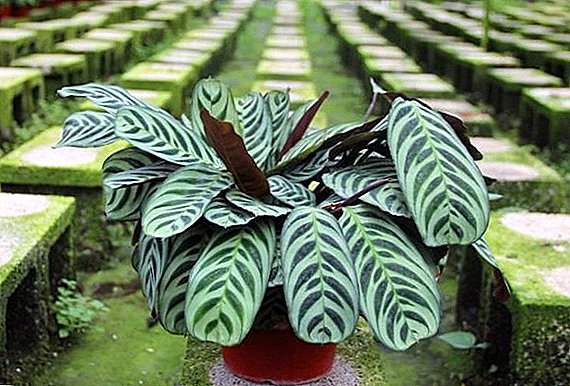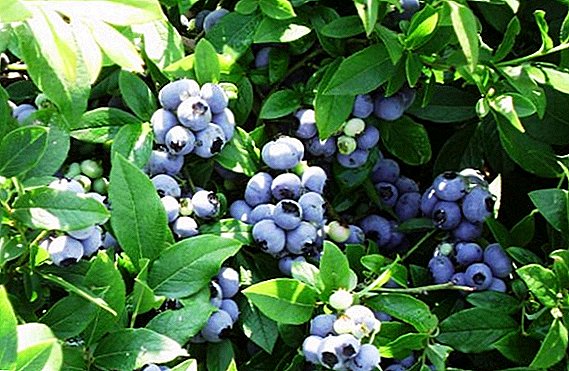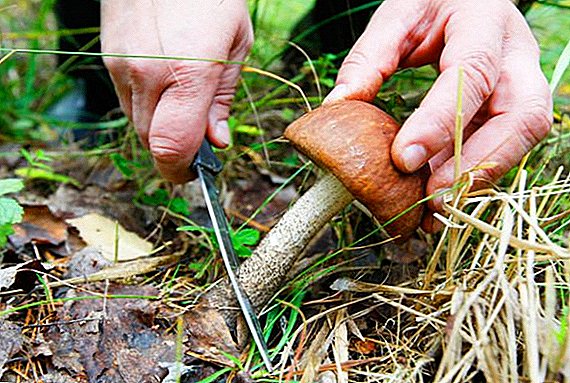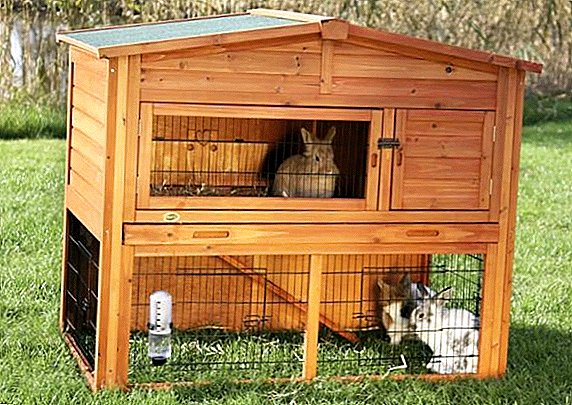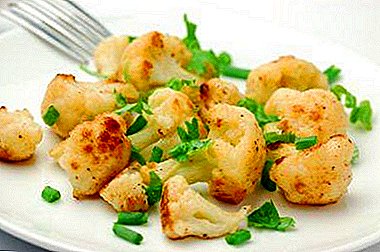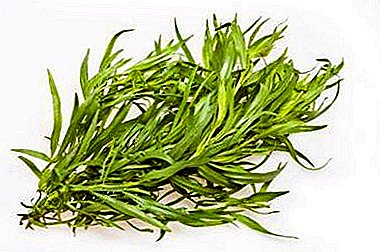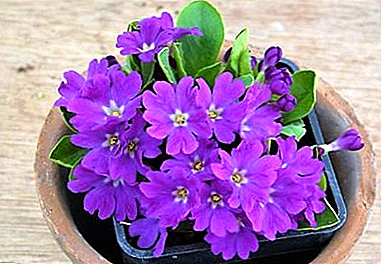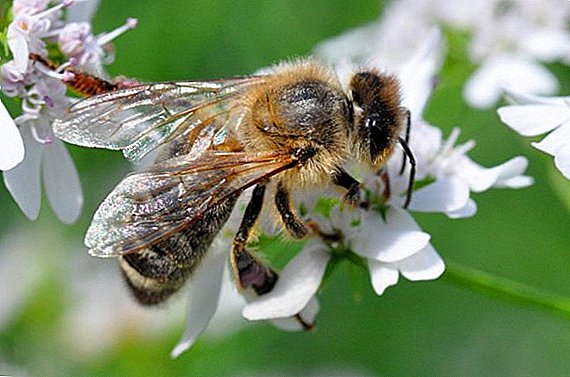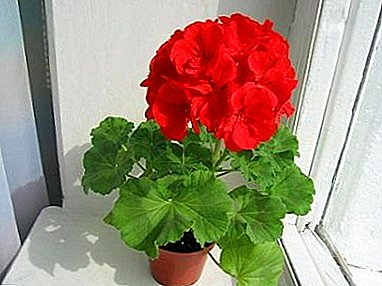
Red geranium in domestic form is grown as a garden plant, it tolerates cold winters and dry summers.
It not only adorns the flowerbeds, but also has healing properties, and according to the adherents of magic, if it is in the house, it protects the home from enemies.
This article will tell you how to care for geraniums, what are common diseases and the fight against them, as well as what are the popular varieties.
History and botanical description
Botanical name of the species: blood red or blood red geranium (Geranium sanguineum). The plant has many common folk names. - Blood Crane, field lovage, marlitz, thunder.
Distribution history
Blood-red geraniums in the wild grow throughout Europe, in the European regions of Russia and in the Caucasus. In the XVI century, it was cultivated by English gardeners, but only in the middle of the XX century, with the advent of fashion in the gardens in a natural style, the plant firmly settled on the backyards and cottages.
Important! According to the teachings of Feng Shui, the flower harmonizes the space around it, neutralizes unfavorable energy. Attracts love, relieves bouts of anger.
Botanical description
 The blood-red geranium belongs to the genus Geraniums of the Geraniaceae family. This is a herbaceous perennial plant, its average life expectancy is 12-15 years.
The blood-red geranium belongs to the genus Geraniums of the Geraniaceae family. This is a herbaceous perennial plant, its average life expectancy is 12-15 years.
Bush spherical shape with a height of 50-80 cm. The root system is powerful, rod type. The main root is well pronounced, knotty, thick.
Stem up from the root, ascending or recumbent, rigid, bright green, strongly branching, forked, pubescent stems with numerous leaves.
Wintering pilchat-dissected leaves are divided into 5-7 narrow lobes.which, in turn, are divided into several linear or linear-lanceolate lobes. Below the bright green leaf is covered with whitish fibers.
In the fall, the lower leaves, stalks at the base at the base acquire a bright carmine-red color, giving the cutlets a special appeal. In regions with a warm climate, part of the foliage remains green all winter, keeping decorative all year round.
Peduncles straight, slightly rising above the leaves, from which the bush is as if covered with flowers. Numerous flowers are large, single (rarely paired), with a diameter of 3-4 cm with 5 petals. Back-shaped petals painted in different shades of red.
The flowering period is long - from June to August. After flowering, fractional fruits are formed, and when ripe they disintegrate into 5 fractions of seeds.
Medicinal properties and contraindications
Fresh and dried roots, the green part and flowers of the plant contain a large number of active ingredients (organic acids, tannins, resins, flavonoids and alkaloids, essential oils, carotene, carbohydrates). In medicine, their healing properties are widely used.:
- anti-inflammatory (stomatitis, inflammatory processes in the intestine, upper respiratory tract);
- antibacterial (skin pathology, seborrhea);
- painkiller (toothache, headache, otitis media);
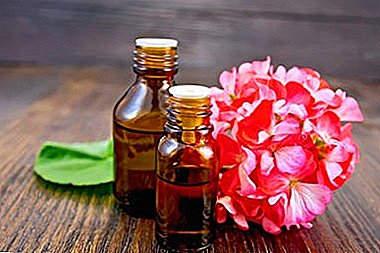 haemostatic (uterine, nasal, hemorrhoidal, pulmonary hemorrhage);
haemostatic (uterine, nasal, hemorrhoidal, pulmonary hemorrhage);- wound healing (suppurating wounds, ulcers, eczema);
- astringent (diarrhea);
- antitumor (initial stage of oncological diseases);
- salt dissolving (gout, rheumatism);
- sedative (neurosis, depression, chronic fatigue, insomnia);
- normalizing blood sugar levels (diabetes).
No obvious contraindications. but preparations containing geranium are not recommended for use:
- individual intolerance;
- pregnancy and lactation;
- duodenal ulcer and stomach, gastritis in the acute phase;
- chronic constipation, intestinal atony;
- thrombophlebitis, thrombosis;
- increased blood clotting.
Popular varieties and photos
There are about two dozen varieties of red geraniums., of which the most in demand:
- Album;
- AlanBloom;
- Compactum;
- Prostratum;
- Nana;
- Elke;
- Genluce;
- Max Frei;
- Prostratum.
One of the most popular varieties - Striatum (Striatum)which sometimes goes on sale under the name Lancastrense. This is a small plant with a height of 10-15 cm, with small light pink, decorated with a central eye and dark veins, numerous flowers.
Further on the photo you can see some varieties of blood-red geraniums.



Where and how to plant?
The plant is unpretentious, however, and it has its own preferences.
Lighting and location
Geranium grows well in sunny or slightly shaded areas. Best suited place lit for half a day. The plant will develop in the shade, but then the flowers will be smaller, and the color is not as saturated.
The soil
Red geranium refers to mesotrophs - plants that live on soils with a moderate mineral content.
Most of all it suits loamy, fertile soil with good aerobic qualities and drainage. It is desirable that the soil was well lime and had a slightly alkaline or alkaline acidity index of pH 7.5-8.5.
Landing
Geranium feels great in one place without transplanting and dividing 10-15 years. If necessary, plant new varieties or create a new decorative element in the garden follow simple rules:
 The optimal landing time is September or March and the beginning of May.
The optimal landing time is September or March and the beginning of May.- Before planting, dig up the soil, while enriching it with peat, moss, humus, sand, and wood ash. In poor soil, in addition to organic matter, 3-4 weeks before planting they additionally introduce complex mineral fertilizer. After digging, carefully remove the remaining roots of weeds.
- Dig holes. When planting stunted, miniature varieties between plants leave a distance of 25-30 cm. If the variety is tall, or it is assumed for a long time to grow the plant in one place without transplant, the distance is increased to 50 cm.
The red geranium has long roots, so the depth of the fossa should be large enough.
- To prevent the root system from rotting, a drainage layer is poured at the bottom of the hole.
- The seedling is carefully placed in the landing hole, sprinkled with earth. The soil is lightly tamped with hands, well watered and sprinkled with mulch.
Care
Flower care is easy and does not require any special expenses.:
- Regular watering is needed only in dry weather. The plant is drought resistant and does not like an overabundance of moisture.
- Weeding is required only in early spring. When the foliage grows up and forms a dense carpet, the weeds will perish themselves.
- Free space between curtains mulch. When exposed to the roots spiked soil.
- Fertilizer is applied three times. Organics are applied before planting, nitrogen fertilizers in May with the beginning of the growing season, potash-phosphate fertilizers during the flowering period.
- Autumn pruning of dry shoots, peduncles and leaves is carried out for better wintering and renewal of the bush in spring. Conducting pruning, leave stumps at least 5 cm long.
Important! Most varieties of red geranium do not require shelter for the winter. With very severe or snowless winters, bushes protect with any covering material.
Common diseases and pests
All members of the genus Geraniums emit a peculiar odor containing phytoncides. It repels pests and prevents the spread of fungal and viral diseases. Geranium planted in a flower garden protects neighboring plants from diseases and pests.
But anything can happen:
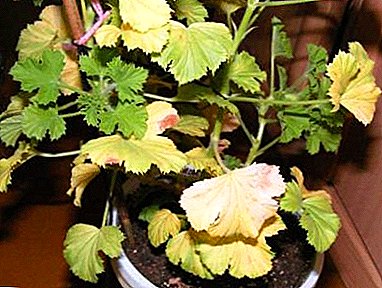 With a lack of moisture, and it will become noticeable on the yellowed leaves, the plant will save abundant watering.
With a lack of moisture, and it will become noticeable on the yellowed leaves, the plant will save abundant watering.- Fallen lower leaves and a bare stem will signal the lack of light. Bush will have to transplant to a new place.
- Waterlogging can cause powdery mildew and brown spot. The affected plant is drastically cut, the cut parts are burned.
- Damage to the root system by the larvae of the beetle moths is possible. To get rid of the misfortunes in the dark, gently dig up the bush, remove the beetle's larvae. The root, the whole plant and the well is treated with a fungicide, the plant is returned to its original place.
Breeding features
Red geranium is easy to propagate by seed, cuttings or division of the bush.
Seeds
Seed propagation is the most time consuming and unreliable way. - varietal characteristics are often not preserved, and in hybrid plants the seeds practically do not ripen. Fading flowers are wrapped in cloth or paper to collect seeds. Sowing is carried out in the fall or early spring for seedlings. The plant multiplies by self-sowing, but flowering occurs only in the second year.
Cuttings
Upper cuts with 3-4 buds are placed in water in a room with room temperature. After 2-3 weeks, cuttings, with a formed root system, are planted, watered and covered with foil.
Cuttings can be stored for quite a long time. To do this, they fall asleep slightly moistened peat and placed in the vegetable compartment of the refrigerator. 2-3 times a month, the soil is moistened with a spray bottle.
Dividing bush
The easiest way to propagate garden geranium is by dividing a bush in early spring. or after flowering. From the dug-out rhizomes of the mother bush with a sharp disinfected knife they separate the young roots and plant them in the soil prepared in advance.
Blood-red geranium is a gardener's dream. The flower, which requires minimal care, not only decorates the garden, but also deters pests from neighboring plants, helps the owner to heal a lot of diseases and even saves from evil spells.


 haemostatic (uterine, nasal, hemorrhoidal, pulmonary hemorrhage);
haemostatic (uterine, nasal, hemorrhoidal, pulmonary hemorrhage); The optimal landing time is September or March and the beginning of May.
The optimal landing time is September or March and the beginning of May. With a lack of moisture, and it will become noticeable on the yellowed leaves, the plant will save abundant watering.
With a lack of moisture, and it will become noticeable on the yellowed leaves, the plant will save abundant watering.